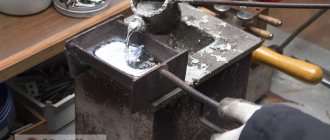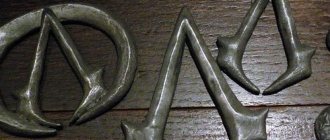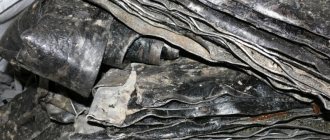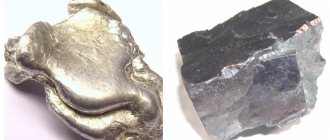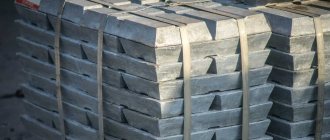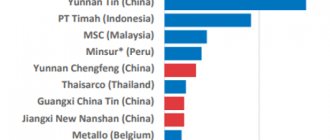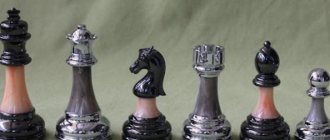Tin is a soft and ductile shiny metal of silvery-white color. It is characterized by good corrosion resistance in atmospheric conditions, soluble in dilute strong acids and concentrated alkalis. Tin is used for coating (tin-plating), producing alloys and solders for soldering, and also as alloying additives.
Tin alloys are systems tin - antimony - copper and tin antimony - lead, which contain from 3 to 90% tin. They are used as antifriction alloys - babbitts for filling bearings and as solders. The use of lead reduces the cost of solder, and the introduction of antimony increases the strength of the seam.
Lead
Lead is a soft malleable ductile metal of light gray color with a bluish tint. Significantly softer than tin, it can be cut with a knife and scratched with a fingernail, and is easily rolled into thin sheets. Lead is resistant to corrosion and the effects of a number of chemicals, especially sulfuric acid. Lead smelting was one of the first metallurgical processes. It is widely used in the chemical industry to protect equipment from corrosion. Lead is used to make sheaths to protect electrical cables, shot, paints and lead batteries.
Lead alloys
Lead alloys have high density and low mechanical strength. They are fusible and resistant to corrosion. Alloys with a predominance of lead are much cheaper than those based on tin. They are used as antifriction alloys - babbitts, as printing alloys and solders. Lead with the addition of tin and antimony becomes much harder.
It is unlikely that anyone will name the exact date of the appearance of tin-lead solder. However, the compound designated “POS” has been known since the Middle Ages. It has optimal properties for joining many metals.
It is easy to melt, and the lead and tin contained in it were mined several thousand years ago. Currently, PIC solder is the most common type of consumable material used in everyday practice.
Basic data
The popularity of tin and lead solders is explained by several factors.
The main feature of alloys is the ability, at a certain ratio of components, to form a composition with eutectic properties. It is an intermetallic system whose melting point is lower than expected values.
One can imagine the joy of the discoverers who discovered that a tin-lead alloy could be heated to a lower temperature to transform it into a liquid state.
Interestingly, the eutectic mixture can serve as a solvent in which a certain additional amount of any metal is distributed upon addition.
Thus, various brands of POS solders were developed. Their technical characteristics indicate proportions and values of physical constants.
It is visually noticeable that when tin predominates in the tin-lead alloy, the solder has a strong metallic luster. If there is more lead in the alloy, the surface has a grayish color with a blue tint.
Metal melting
For tin, the melting point largely depends on whether there are impurities. The temperature at which the metal becomes plastic or liquid can vary from 145 to 250 degrees Celsius, depending on the composition. If necessary, you can melt a large amount of metal to fill it into a mold.
When choosing a material to create a mold, the following points are taken into account:
- The structure should not be wetted by liquid tin. Otherwise, the form may change its size.
- The material used must withstand temperatures of at least 250 degrees Celsius. Otherwise, after filling, the mold will lose its basic performance qualities.
It is worth considering that in liquid form the metal in question can oxidize upon contact with air. The solid substance, on the contrary, has increased resistance to oxygen corrosion.
A three-component alloy based on lead has become quite widespread in electrical engineering. Tin and silver can be used as additional components. When producing such an alloy, attention is paid to the fact that the metal concentration should not be less than 95%. With this option, the combination of substances has a melting point of about 220 degrees Celsius.
Characteristics of individual brands
All representatives of the category belong to low-melting solders. Tin-lead alloys, regardless of the ratio of the starting metals, melt at temperatures up to 450 °C. The characteristics of POS solders are regulated by GOST.
Manufacturers supply solder products:
- in cast ingots;
- in the form of wire products;
- ribbon-shaped foil;
- tubular products with fluxes inside;
- powders or paste.
In general, there is a clear pattern. The lower the mass fraction of tin in tin-lead solder, the higher its melting point and the lower its strength properties.
More than half tin
In an alloy containing 90% tin, the rest of the mass is lead. POS-90 solder has a melting point of 220 ℃.
It is used for soldering products that will subsequently be subjected to galvanic treatment with gold or silver.
Tin-lead solder with 61% tin has a more accessible melting point of 191 ° C. POS-61 is used for the manufacture of thin contacts for parts made of copper and steel alloys in various measuring instruments. The areas where the alloy is applied should not be exposed to strong heat.
Solder can be used for soldering wires up to 0.08 mm thick in a winding. It may be exposed to high frequency currents.
Read also: Single-cylinder four-stroke engine operating principle
Solder is used in all situations that require great strength and reliability of the connection of radioelements and microcircuit components. They can be used to solder wires protected by a polyvinyl chloride sheath.
Tin-lead solder containing equal shares of two metals is designated as POS-50. It melts at 222℃. Applicable in all situations where POS-61 can be used.
The difference is that this solder has a higher melting point. If the contact can heat up this quality will be useful.
Less than half a tin
Seams for which there is a high probability of heating to even higher temperatures should be soldered using POS-40 solder. The melting point of a tin-lead alloy containing from 39% to 41% tin is 238 °C.
Please note that the presented indicators are typical for the final melting of the alloy. The process begins at slightly lower temperatures.
The alloy is designed to work with wires and parts made of different metals. The resulting seam has a smaller margin of safety than joints made with alloys with a higher mass fraction of tin. Solder is used to make connections that are not subject to heavy mechanical stress.
The POS-30 alloy has an even higher final melting temperature. It is equal to 256 ℃.
This tin-lead solder is used for soldering non-stress joints in copper and steel materials.
POS-18 solder finally melts at 277 ℃. The resulting seam has little mechanical stability.
The presented tin-lead alloy can be used for tinning, soldering unloaded copper parts, and galvanized iron products.
The tin-lead alloy, containing only 10% tin, has the maximum melting point in this series, equal to 299 ℃, and the minimum strength.
POS-10 can be used for soldering and tinning contacts on the surface of relay devices. GOST allows the use of the composition for processing control points in the furnaces of steam locomotives. Currently, steam locomotives remain only in museums; sometimes they have to be repaired and restored.
Solders marked POS are antimony-free consumables.
Tin and Lead (page 1)
TIN AND LEAD
Tin and lead are in the main subgroup of Group IV of the Periodic Table, which also includes carbon C, silicon Si and germanium Ge. The first two elements are non-metals, germanium belongs to the transition elements, and tin and lead are typical metals. Therefore, in this section, tin and lead will be considered separately from the other elements of the main subgroup of group IV.
Historical information.
Tin and lead are among the seven metals known to mankind since ancient times, so the exact date of their discovery is not known. It should be noted that until the advent of AD. e. tin and lead were often confused with each other, since both metals have similar properties. Echoes of this misconception have survived to this day: for example, in some Slavic languages (Bulgarian, Serbian, Czech, Polish) the metal lead is called the word tin.
The first mention of pure tin dates back to the 2nd millennium BC. e. The metal was obviously inaccessible and expensive, since tin objects are rare among Roman and Greek antiquities. The discovery of tin was most likely due to the accidental recovery of cassiterite (tin stone), the alluvial deposits of which occur at or close to the earth's surface. Another factor that contributed to the discovery of the metal was that tin ores are much easier to reduce than ores of other metals. But long before they learned to extract tin in its pure form, mankind widely used an alloy of tin and copper (bronze), which was obtained already in the 4th millennium BC. e. Throughout the Bronze Age, this alloy was, in modern terms, a strategic material: tools, weapons, household items, etc. were made from it.
The first lead products date back to the 3rd millennium BC. e. (Mesopotamia, Ancient Egypt). The metal was discovered due to the widespread availability of its ores and the ease with which it could be smelted - it was enough to put lead ore in a fire with a large amount of charcoal and create draft (constant access of fresh air).
The origin of the Latin and Russian names of both metals has not been established for certain. One version sounds like this: the Latin word stannum
(resistant) originally referred to an alloy of lead and silver, later to another alloy imitating it, containing about 67% tin, and only from the 4th century AD. e. this word began to be called tin.
Distribution in nature
. Tin and lead do not belong to the group of the most common elements in the earth's crust, but they are not rare metals either.
Both metals are found in nature mainly in the form of oxygen or sulfur compounds, among which cassiterite (tin stone) SnO2, stannite (tin pyrite) Cu2S∙FeS∙SnS2, galena (lead luster) PbS, anglesite PbSO4 and cerussite PbCO3 are of industrial importance. In total, about 25 tin and more than 100 lead minerals are known. Tin and lead are extremely rarely found in a native state.
Physical properties
. Tin has two allotropic modifications. Under normal conditions, the β-form (white tin) is stable - a shiny silvery-white metal. Gradually, the shine disappears as an oxide film forms on the metal surface. At temperatures below –13°C, white tin transforms into the α-form (gray tin); this transition occurs especially quickly at temperatures below –30°C. α-Tin is a gray metal similar in appearance to lead. In addition to color, the two modifications of tin differ in density and ductility. White tin, with a density of 7.29 g/cm3, is slightly heavier than gray tin, whose density is 5.85 g/cm3. β-Tin is a soft and ductile metal, it is easily rolled into thin foil (staniol), while gray tin does not have ductility and easily crumbles into powder.
There are many cases where products made of white tin turned gray in the cold and were destroyed. This phenomenon is called the “tin plague.” The reason for the destruction is a sharp increase in the volume of the metal, because the density of white tin is greater than that of gray tin, and therefore, with equal mass, α-tin will occupy 25-26% more volume compared to the β-form. The transition from one form of tin to another is facilitated by the contact of white tin with particles of the gray form, and it spreads like a “disease.” This “disease” is one of the reasons for the death of Scott’s expedition to the South Pole in 1912. On the way back, the participants were left without fuel due to the fact that it leaked through the tin-sealed tanks affected by the “plague”.
Lead is a dirty gray metal, but when cut fresh it has a bluish tint and shines. However, the shine quickly disappears as the metal is covered with a protective film of oxide. Lead is one of the heaviest metals: its density is 11.34 g/cm3, which is about one and a half times more than iron, or four times more than aluminum. It is not for nothing that in Russian the word “lead” is synonymous with “heavy”. In addition, lead is one of the softest metals and can be easily scratched with a fingernail or cut with a knife.
Both tin and lead belong to the group of fusible metals. Their melting points are 232°C and 327°C, respectively. Boiling points: for tin 2270°C, for lead 1750°C. But long before the boiling point is reached, tin and lead begin to evaporate. For tin, volatility begins at approximately 1200°C, for lead – at 700°C. The latter must be remembered by those who work with lead at elevated temperatures, since the metal itself, as well as its compounds, are toxic. Once in the body, lead accumulates in the bones, causing their further destruction.
The electrical conductivity of tin and lead is low for metals. If we compare both metals with copper, they are about 10 times worse at conducting electric current.
Chemical properties
. The electronic configuration of tin and lead atoms ends at ns2np2, where n is the number of the last (outer) electron layer. Therefore, both metals can exhibit valences II or IV. Tin exhibits both valences equally, but tetravalent tin compounds are more stable. In lead, the divalent state predominates over the tetravalent state, so in most compounds it exhibits valency II. In addition, the atoms of both metals contain unfilled p and d orbitals, which affects the ability of tin and lead to form complexes.
Since tin and lead are located immediately before hydrogen in the electrochemical voltage series of metals, they can be classified as low-active metals. Moreover, the presence of an oxide layer on the metal surface affects the decrease in their reactivity.
At room temperature, tin and lead are resistant to most non-metals and combine only with chlorine and bromine, while tin exhibits valency IV, and lead exhibits valency II:
But if you select certain conditions, you can get tetravalent lead chloride (lead (IV) bromide and iodide do not exist, since tetravalent lead is a strong oxidizing agent and it would oxidize bromide and iodide ions to free halogens):
However, lead(IV) compounds are generally unstable and are easily converted to divalent lead compounds:
At elevated temperatures, the chemical activity of metals increases significantly, and they react with oxygen, fluorine, iodine, sulfur, selenium and tellurium. In addition, when heated, tin reacts with phosphorus and nitrogen. And again there is a difference in valence: tin, as a rule, exhibits valency IV, while lead exhibits valency II:
Only when reacting with sulfur are both metals divalent:
There is also tetravalent tin sulfide SnS2, which is obtained by indirect methods, for example, by passing hydrogen sulfide through acidified solutions of tin (IV) salts. Lead(IV) sulfide does not exist for the same reason that lead(IV) bromide and iodide are never formed.
Both metals do not interact with cold or boiling water, but at elevated temperatures they are able to decompose water vapor:
It is the inertness of tin in relation to water and oxygen under normal conditions that explains the use of this metal in the coating of tin containers for food products. In addition, metal tin and its corrosion products are relatively harmless to the human body. Lead was used for some time for these purposes, but after it became known about its toxicity, it was abandoned.
Since tin and lead are located in the series of metals to the left of hydrogen, they are able to react with acids. In this case, both metals exhibit valence II, with the exception of concentrated sulfuric and nitric acids - with them tin is already tetravalent. Due to the low chemical activity of metals, their dissolution in acids occurs extremely slowly. For example, dilute hydrochloric and sulfuric acids begin to have a noticeable effect on tin only when heated. At room temperature, the reaction occurs at a very low speed, making it almost impossible to notice the bubbles of the gas being released:
| Due to its large volume, this material is placed on several pages: 1 |
